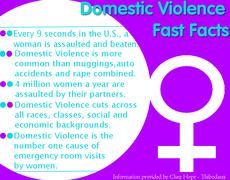They have been together for years and the unruly arguments they pursue have existed for the same amount of time. As the couple argues in the privacy of their home, fists fly and no one is aware except for those involved. Next time, there may not be a next time. According to a brochure written and produced by the National Woman Abuse Prevention Project, researchers estimate that three to four million women are abused in the home each year by their husbands or partners. Approximately 95 percent of domestic violence victims are women, according to the Department of Justice.
The University handles approximately four or five domestic violence cases per semester. Most cases go unreported, Craig Jaccuzzo, University Chief of Police, said. He said it is most commonly reported when a violent act escalates to cause an injury or almost death.
“A trend that law enforcement officers are seeing across the country and in this region is the escalating murder/suicide rate between relationships that have gone wrong,” Jaccuzzo said.
Domestic violence is any incident of threatening behavior, violence or abuse between adults who are or who have been in a relationship together, between family members, regardless of gender or sexuality, according to Jaccuzzo. In order to be considered domestic violence, the aggressor and victim must be living together and trends in domestic violence are not unique to anyone, he said.
According to the Bureau of Justice Statistics, domestic violence includes intimate partner violence, as well as violence between family members. It occurs among all races, ages and religions, and to people of all education and income levels.
The brochure written and produced by the National Woman Abuse Prevention Project titled “Domestic Violence, Understanding a Community Problem” is one of the few that are given to victims of domestic violence by University police. This is consistent among any agency that handles domestic violence, Jaccuzzo said.
Victims are always “direct[ed] to some type of resource to let them know their rights as a victim” and informed of counseling services available. A “channel of communication” is always left between the victim and the police department, Jaccuzzo said.
A random sample of approximately 3,400 women in a group health program in the United States found that 44 percent of them experienced intimate partner violence in their adult lifetime, according to the Group Health Cooperative Center for Health Studies, ghc.org.
“Some people might not realize they’re in an unhealthy relationship,” Jaccuzzo said. “That cycle from the home to the relationship may continue. (The victim) may think, ‘this is how it’s always been. I accept it,’ and sometimes professionals intervene to let you know it’s unhealthy.”
Separation from a spouse or loved one is one factor that sometimes prevents victims from reporting domestic violence, Jaccuzzo said.
“Or, it’s the fear itself of making that big step of saying it’s over,” he said.
According to the Bureau of Justice Statistics, “violence between intimates is difficult to measure because it often occurs in private and victims are often reluctant to report incidents to anyone because of shame or fear of reprisal.








